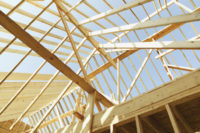Recent talks at the International Builders’ Show in Las Vegas agree on the housing market gaining momentum in 2013. NAHB Chief Economist David Crowe said that house prices are up nearly 6 percent on an annualized rate over the past 10 months, and that “this has been a trigger for demand to return. People feel comfortable if they buy a house that it will appreciate, not depreciate, in value.”
Other factors that bode well for the housing outlook include low mortgage rates, strong housing affordability, rising household formations and the fact that two-thirds of U.S. housing markets can now be considered improving, according to the NAHB/First American Improving Markets Index.
For the last five quarters, housing has acted as a net contributor to the economy, steadily increasing its share to 12.8 percent of economic growth in the fourth quarter of 2012.
The recovery faces pitfalls
However, Crowe cautioned that builders continue to face several challenges, including stubbornly tight mortgage lending conditions, inaccurate appraisals, rising materials prices and a declining inventory of buildable lots.
Moreover, continuing gridlock in Washington over how much more fiscal tightening is needed to stabilize the debt-to-GDP ratio, along with calls by some policymakers for major changes to the mortgage interest deduction, threaten to negatively impact consumer confidence and future housing demand.
Setting the 2000-2003 period as baseline benchmark for normal housing activity, Crowe reported that residential remodeling has returned to previously normal levels and that remodeling activity is expected to post a 2.4 percent increase in 2013 over last year.
Meanwhile, multifamily production, which has posted a 273 percent gain from its fourth quarter trough of 82,000 units in 2009 to 306,000 units in the final quarter of 2012, is expected to reach what is considered a normal level of production by 2014.
The single-family market, which has the farthest to go, was running at 44 percent of normal production in the fourth quarter of 2012. Single-family starts are expected to steadily rise to 52 percent of what is considered a typical market by the fourth quarter of this year and 70 percent of normal by the fourth quarter of 2014.
NAHB is forecasting 949,000 total housing starts in 2013, up 21.5 percent from 781,000 units last year.
Single-family starts are anticipated to rise 22 percent from 535,000 last year to 650,000 in 2013, Crowe said. They are expected to jump an additional 30 percent in 2014 to 844,000 units.
On the multifamily side, NAHB is anticipating that starts will increase 22 percent from 246,000 units last year to 299,000 in 2013, and rise an additional 6 percent to 317,000 units in 2014.







